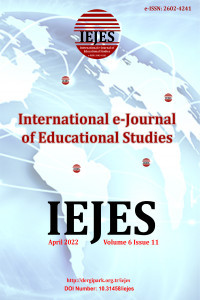Peer Bullying Experiences and Management Strategies of Preschool Teachers
Peer bullying, preschool education, teacher, educational program, values education
Peer Bullying Experiences and Management Strategies of Preschool Teachers
Peer bullying, preschool education, teacher, educational program, values education,
___
- Akduman, G.G. (2012). Okul öncesi dönemde akran zorbalığının incelenmesi [Investigation of peer bullying in preschool period]. Toplum ve Sosyal Hizmet, 23(1), 107-120.
- Alsaker, F. D. & Gutzwiller-Helfenfinger, E. (2009). Social behavior and peer relationships of victims, bully-victims, and bullies in kindergarten. S. R. Jimerson, S. M. Swearer, & D. L. Espelage (Eds.), Handbook of bullying in schools an international perspective (pp. 87-99). Routledge.
- Atış-Akyol, N., Yıldız, C. & Akman, B. (2018). Teachers’ views of peer bullying and their coping strategies with bullying. Hacettepe University Journal of Education, 33 (2), 439-459.
- Bakkaloğlu, A.B., Eryılmaz, A., & Sapsağlam, Ö. (2019). The scale of happiness strategies for children’s used by preschool teachers. Journal of Computer and Education Research, 7 (13), 171-182. https://doi.org/10.18009/jcer.535593
- Çarkıt, E. & Bacanlı, F. (2020). Okullarda akran zorbalığı: Öğretmen görüşlerine göre nitel bir çalışma [Peer bullying in schools: A qualitative study according to teachers’ opinions]. OPUS-Uluslararası Toplum Araştırmaları Dergisi, 15(24), 2545-2583.
- Darga, H. (2021). Anasınıfına devam eden 5-6 yaş grubu çocukların evlerinde oynadıkları dijital oyunların ve ebeveynlerin davranışlarının belirlenmesi Journal of Computer and Education Research, 9 (17), 447-479. https://doi.org/10.18009/jcer.876987
- Finnegan, R. A., Hodges, E.V. & Perry, D. G. 1998. Victimization by peers. Journal of Personality and Social Psychology, 75, 1076- 1086. https://doi.org/10.1037/0022-3514.75.4.1076
- Fu, X., Li, S., Shen, C., Zhu, K., Zhang, M., Liu, Y., & Zhang, M. (2023). Effect of prosocial behavior on school bullying victimization among children and adolescents: Peer and student–teacher relationships as mediators. Journal of Adolescence, 95, 322– 335.
- Gillies-Rezo, S. & Bosacki, S. (2003). Invisible bruises: Kindergartens’ perceptions of bullying. International Journal of Children’s Spirituality, 8(2), 163-177.
- Gündoğdu, S. & Yaşar, M. (2021). Okul öncesi dönemde çocuklar arasındaki sınıf içi güç ilişkilerinin incelenmesi. Ondokuz Mayıs University Journal of Education Faculty, 4 (1), 122-141.
- Hanish, L. D., Ryan, P., Martin, C. L. & Fabes, R. A. (2005). The social context of young children’s peer victimization. Social Development, 14(1), 2-19.
- Hay, D. F., Caplan, M., & Nash, A. (2009). The beginnings of peer relations. K. H. Rubin, W. M. Bukowski, & B. Laursen (Eds.), Handbook of peer interactions, relationships, and groups (pp. 121- 142). The Guilford Press.
- İnan, H. Z., (2011). Okul öncesi egitim programında değerler egitiminin kapsamı, Unite 5. A.Arıkan (Ed.), Okul öncesi dönemde değerler eğitimi (pp.95-122). Eskisehir Anadolu Üniversitesi Yay.
- Koyutürk- Koçer, N. & Gültekin-Akduman, G. (2016). Peer-Bullying during the preschool period. E. Atasoy, R. Efe, I. Jażdżewska & H. Yaldır (Eds.), Current advances in education, 418-427. St. Kliment Ohridski University Press.
- McGinnis, E., & Goldstein, A. P. (2003). Skillstreaming in early childhood: new strategies and perspectives for teaching prosocial skills (Revised ed.). Champaign, Research Press.
- Mendez, J. L., Fantuzzo, J. & Cicchet- ti, D. (2002). Profiles of social competence among low-income African- American preschool children. Child Development, 73(4), 1085-1100.
- Mercan, H. (2020). Examining 60-72 month old children’s self regulatory skills and strategies of coping with bullying (Master Thesis). Istanbul Medipol University.
- Ministiry of National Education [MoNE]. (2021). Retrieved December13, 2021, from https://orgm.meb.gov.tr/www/akran-zorbaligi-ve-siber-zorbalik-egitimlerimiz-basladi/icerik/1763
- Monks, C. P., Smith, P. K. & Swettenham, J. (2005). Psychological correlates of peer victimisation in preschool: social cognitive skills, executive function and attachment profiles. Aggressive Behaviour, 31(6), 571-588. https://doi.org/10.1002/ab.20099
- Olweus, D. (1980). Familial and temperamental determinants of aggressive behaviour in adolescents boys: A causal analysis. Developmental Psychology, 16, 644-660.
- Özdemir, S. (2014). Examination of aggressive behaviors seen in preschool children. [Unpublished doctoral dissertation], Selçuk Üniversitesi, Konya.
- Özözen-Danacı, M. & Çetin, Z. (2016). Erken çocukluk döneminde görülen okul zorbalığı davranış eğilimlerinin çocukların kişisel/sosyal–dil–motor gelişimleri ile olan ilişkisi. Hacettepe University Faculty of Health Sciences Journal, 3(2), 53-72
- Perren, S. (2000). Kindergarden children involved in bullying: Social behaviour, peer relationships and social status [Unpublished doctoral dissertation]. University of Bern.
- Rodkin, P. C., & Hodges, E. V. E. (2003). Bullies and victims in the peer ecology: Four questions for psychologists and school professionals. School Psychology Review, 32(3), 384-400.
- Scheithauer, H., Hayer, T., Petermann, F., & Jugert, G. (2006). Physical, verbal, and relational forms of bullying among German students: Age trends, gender differences, and correlates. Aggressive Behavior, 32, 261-275. https://doi.org/10.1002/ab.20128
- Tanrıkulu, I. (2020). Teacher reports on early childhood bullying: How often, who, what, when and where, Early Child Development and Care, 190(4), 489-501.
- Başlangıç: 2017
- Yayıncı: Tamer KUTLUCA
Nimet BARÇIN, Arzu AYDOĞAN YENMEZ
Examination of Foreign Students’ Anxiety in Learning Turkish in Terms of Various Variables
Yusuf ALPDOĞAN, Semra OMAK, Müzeyyen ELDENİZ ÇETİN
Distance Education Competencies of Physical Education Teachers: Elazığ Province
Oğuzhan ALTUNGÜL, Didem YAVUZ SÖYLER
Tuba YENİL, Burçin GÖKKURT ÖZDEMİR
Examination of Fair Play Approaches of High School Students who Participate in School Sports and not
